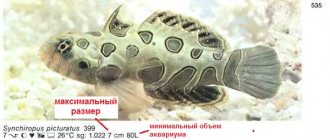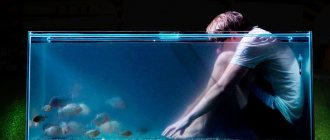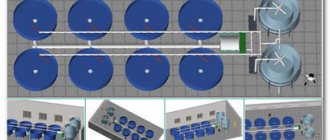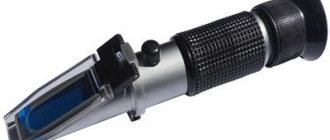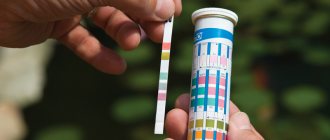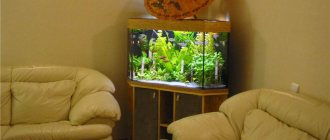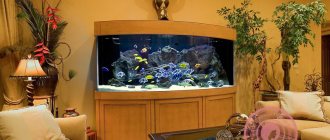Children often ask their parents to get some kind of animal. One of the first options that usually comes to mind is an aquarium. 100 liters of water, some river sand and pebbles, several beautiful fish, colorful algae - and no hassle with walking, hair after shedding, drooling and scratched furniture. The main thing is silence, which is sometimes so lacking. However, choosing the right vessel is not an easy task.
The quietest pets you can have at home are fish.
Marine aquarium salt
Under no circumstances should you use regular table or cosmetic salts for aquariums. Only sea salt, sold in specialized stores, will be harmless to the inhabitants of your aquarium. The most versatile and high-quality options may be the products of the companies “Red Sea” and “Tropic Marin”; their composition is perfect even for aquariums that recreate coral reef ecosystems.
Plants
Plants are planted in a 100-liter aquarium to create an attractive design and enrich the water with oxygen. Suitable for this volume:
- hornwort;
- riccia;
- Anubias;
- Java moss;
- cryptocoryne;
- Vallisneria;
- elodea.
Hornwort.
Riccia.
Anubias.
Java moss.
Cryptocoryne.
Vallisneria.
Elodea.
On a note! Plants should be in harmony with each other, the inhabitants of the pond and the overall design.
Instruments for measuring and monitoring parameters in a marine aquarium
Most inhabitants of marine aquariums can only feel comfortable in water with certain properties. Temperature, density, salinity, oxygen saturation and many other parameters of aquarium water can be monitored and controlled using a certain set of measuring equipment. Let's take a closer look at several types of such equipment.
A refractometer is an optical instrument that professionally measures the salinity and density of water. It evaluates the degree of refraction of a beam of light passing through a tiny sample of water, a few drops in volume. And based on how strong the refraction (refraction) of light in the sample is, it gives an exact value for the density of water, as well as the percentage of salts it contains.
A hydrometer is a kind of high-precision thermometer (although it does not measure temperature). So highly accurate that such devices are often used in laboratory research. To determine the salinity of water, a hydrometer requires a strictly specified water temperature of 25°C. You simply immerse the device in a filled aquarium and determine its salinity level in a matter of seconds. On the scale of each hydrometer there is a green zone, within which salinity is considered normal for aquarium animals
Hydrometer is a device that measures the salinity and density of water. It also requires a liquid of a certain temperature (25 °C), at which accurate data on the salinity of sea water is displayed on a large and convenient hygrometer scale.
Check-in
To reduce the level of stress and anxiety, it is better to transplant purchased animals into a prepared marine aquarium in the dark. The first inhabitants should be unpretentious. First you can introduce mollusks and arthropods, then after a week fish (not aggressive or territorial). Corals are planted last, no earlier than 2 weeks later.
During the settlement process, constant monitoring of water quality is necessary. There is no need to rush to accommodate everyone. When the last fish are added to the aquarium, and the concentration of ammonium and nitrites is stably below 0.1 mg/l, the start-up period is considered to be successfully completed. But the final biological balance will be established only after 3-5 months.
Despite the fact that a marine aquarium is a costly project and requires a lot of effort to start, you should not immediately abandon this idea. If you already have some experience with a freshwater body of water, and you feel the strength and desire, go for it. We hope that this article will help you navigate at the initial stage.
Video tutorial from the Living Water channel on starting a marine aquarium:
Live rocks for marine aquariums
live rocks for marine aquarium
live rocks for marine aquarium
Living rocks are a very important component of the marine ecosystem. Actually, why are these stones called “living”? Each such stone, in fact, is not a real stone. In most cases, it is a piece of the surface of a coral reef and has a porous structure, becoming a sort of large apartment building for a great variety of microscopic algae and animal organisms. They pass sea water through themselves, processing potential pollutants (nitrates, phosphates, various organic acids, etc.) into chemically and biologically neutral compounds. The water becomes cleaner, safer and healthier for fish and other aquarium inhabitants. This is also facilitated by the chemical composition of living stones, which enriches the water with calcium, magnesium ions, bicarbonate ions and other minerals. Such stones can either be located directly on the aquarium bottom (some of them look damn impressive) or lie in the biofilter. And over time, the microorganisms inhabiting them will gradually leave their native stone apartments, finding new corners for themselves in tiny cavities of the soil or decorations, without ceasing to carry out their beneficial filtering mission.
Live stones are small/broken.
Exactly the same stones, only crushed to the state of coarse crumbs. They are used in the cavities of aquarium filters, where they become an excellent replacement for the sponge found there by default. Unlike standard sponges, small living stones are a much more powerful barrier against harmful substances such as nitrates.
Advantages and disadvantages
The advantages of 100-liter aquariums include:
- the ability to place all necessary equipment inside the container;
- ease of establishing and maintaining biological balance;
- the possibility of settling fish and invertebrates of medium size;
- possibility of planting a variety of plants;
- possibility of creating original aquadesign.
The disadvantages of such reservoirs include:
- large sizes and, as a result, the need to allocate space for installation;
- the need for installation on a solid and perfectly level base (you may need to purchase a special cabinet for an aquarium);
- when assembling it yourself, you need to choose durable glass that can withstand water pressure.
Live sand for a marine aquarium
live sand for a marine aquarium
Live sand contains both an inorganic substrate and tiny forms of living organisms - invertebrates and bacteria. A 3-6 centimeter layer of sand at the bottom of the aquarium will have both an aesthetic function, creating the feeling of a real seabed, and a whole range of practical functions that will benefit the entire aquarium.
— Many fish and other aquarium inhabitants use live sand as an abundant and constant source of food - the living organisms contained in it multiply at an enviable rate, maintaining a stable amount of organic matter in the sand. Some other fish species swallow sand to improve digestion.
—Living sand helps maintain the balance of chemicals in the water. Its alkaline structure has a positive effect on the pH level, and new calcium and strontium ions, important for many aquarium inhabitants, are continuously released into the water.
— Of course, living sand itself is home to many biological species - sea stars, darters, bottom-dwelling fish, crustaceans. They will not be able to live in an aquarium without a sufficient layer of live sand at the bottom.
Like living stones, sand also tends to “age” over time. Experts recommend either completely changing it, or simply periodically adding a little fresh live sand to the bottom. You cannot keep a container with live sand open for more than a day, otherwise it may result in death for the organisms inhabiting it.
Summing up, we can conclude that creating a piece of the sea at home is not at all difficult and relatively budget-friendly. A fully finished system for 30 liters will cost you 36,550 rubles.
Choosing the best option
Be that as it may, those who decide to install an aquarium in their home must decide what they want. To do this, it is important to think through the following points:
- Main purpose of purchase. Who are they buying the tank for? It can become a home for mice or fish, or maybe turtles will be kept in it. Someone takes an aquarium simply to decorate the interior.
- Installation location. This is a very important question for selection. Not every object can fit in the right place, so they immediately decide not only on the shape, but also on the volume of the future acquisition.
It is necessary to decide which of the existing aquarium options is needed, for what purposes and for what pets
- Availability of funds. A question that can be decisive in determining the optimal option.
- Studying the supply market. A thorough analysis of all the products offered will help you choose the best one.
Having once decided to install an aquarium in their home, many are faced with additional problems, however, having successfully overcome them, they enjoy admiring the underwater world. The sight of beautiful fish swimming carefree behind the glass calms you down and helps relieve the stress that has accumulated during the day.
Photo selection of beautiful marine aquariums
Story -
Video history of the development of my marine aquariums – https://www.youtube.com/user/VLADECcom
My “method” of maintaining a marine aquarium has been tested on small (from 1L to 400L) marine aquariums. On systems larger than 400 liters, my “method” has not been tested, due to the lack of a larger marine aquarium - in the future it is planned to test this “method” of maintaining a marine aquarium on an aquarium of approximately 1750 liters.
Experimental marine aquarium 110l TM Nature. This is where my journey in marine aquarium farming began, starting with a complex and academic approach (samp, foam, algae, scrubber, mangrove, weekly changes of 10%)
Start -
The principle of building a marine aquarium with an upper sump -
The following is the story of simplifying the filtration system and the approach to maintaining a marine aquarium. January 27, 2011 launch of a 110 liter marine aquarium.
The system has:
- two foams – resun sk-05 protein skimmer
- heater at 50w.
- water supply to the sump – Atman AT-203
- flow pump – ViaAqua-100A
- light MG-150W 20000k. + 2pcs. PL24W (1 piece blue + 1 piece blue+white)
- scrubber
- mangrove
With such a set of equipment, this marine aquarium could easily digest one chocolate cube of frozen brine shrimp per week, without any visible consequences, in the form of a film on the surface of the water and algae fouling. Since December 1, 2012, the marine aquarium lives without replacement and on topping up of settled drinking water supply. from November 14, 2013 a marine aquarium lives without a sump
The following remain in the system:
- heater at 50w.
- flow pump – ViaAqua-100A
- light MG-150W 20000k. + PL24W (blue+white)
from October 9, 2014
The system has:
- heater 2 pcs. at 50w.
- flow pump – Boyu WM-2
- light MG-150W 20000k. + 4pcs. T5-24W (actinics) + 7 pcs. sd. Cree blue.
until August 24, 2016
The saltwater aquarium is doing fine. I didn't make any changes. I did not add any additives for a marine aquarium.
Changes in the marine aquarium during this time: From the equipment, a JVP current pump was added (due to the strong growth of corals and the natural deterioration of the flow in a marine aquarium). From the living creatures, the brown zebrosoma was added and the chromis disappeared. Recent video of my 2021 saltwater aquarium. —

